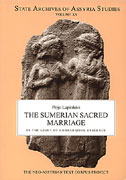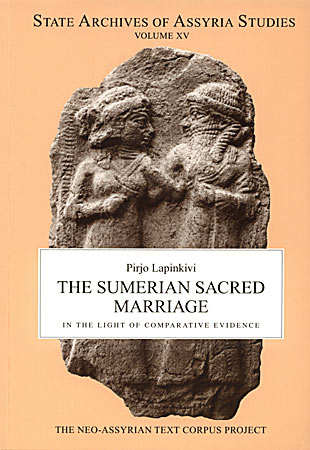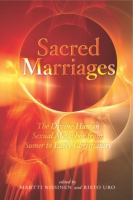The Sumerian Sacred Marriage in the Light of Comparative Evidence
Pirjo Lapinkivi
The primary purpose of this study is to increase understanding of Sumerian sacred marriage by approaching it from a comparative perspective. More generally, it is hoped that the study will illustrate the fruitfulness of the comparative approach for the study of Sumerian religion and royal ideology and that it will prove useful to the other fields of study whose sources were used as the comparative evidence.
- Description
- Table of Contents
- Subjects
The comparative evidence includes sources from six different fields of study: Assyriology (first and second millennium love lyrics and rituals), Biblical studies (The Song of Songs), Classics (Graeco-Roman philosophies, Chaldean Oracles), Gnostic studies, Jewish mysticism (Kabbalah) and Indology (Hindu rites and myths). Ancient Egyptian and Ugaritic evidence is also used.
Part One of the study presents and analyzes the primary evidence for the Sumerian sacred marriage, starting with the Sumerian love song corpus, also known as the Dumuzi-Inanna (DI) love songs. In addition to the love song corpus, the evidence discussed in Part One includes second millennium literary texts and royal inscriptions referring to a marital relationship between the ruling king and Inanna/Ištar.
Part Two analyzes and discusses the constituent elements of the Sumerian sacred marriage (the actors of the marriage, and the timing and scene of the related ritual). At this point, some comparison with the parallel material is inevitable.
Part Three presents the comparative evidence and a detailed analysis of the thematic elements shared by the different traditions. This section also includes a discussion of the concept of the soul in Mesopotamia and in other parts of the ancient world. Concepts of the Netherworld and afterlife in Mesopotamia are also examined.
Acknowledgements
Abbreviations
Introduction
0.1. Sacred marriage: A Definition
0.2. Previous Views on the Sumerian Sacred Marriage
0.3. Problems with the Understanding of the Sumerian Sacred Marriage
0.4. The Comparative Approach
0.5. The Relevance of the Comparative Evidence
0.6. The Comon Elements of the Different Traditions
0.7. Problems of Comparison and Possible Pitfalls
0.8. The Esotericism of Sacred Marriage Traditions
0.9. The Method
0.10. The Aims and Scope of the Study
0.11. Organization of the Study and Manner of Presentation
0.12. Terminology and Conventions
Part One: The Evidence
1.1. Introduction
1.2. Dumuzi-Inanna Love Songs
1.3. Other Sumerian Evidence
1.4. Archaeological Evidence
Part Two: Constituents of the Sumerian Sacred Marriage
2.1. The Actors in the Sacred Marriage
2.2. The Timing of the Sacred Marriage of Inanna and Dumuzi
2.3. The Scene of the Sumerian Sacred Marriage
Part Three: Comparative Evidence and Thematic Analysis
3.1. The First Millennium Textual Sources in Mesopotamia
3.2. The Song of Songs
3.3. Jewish Mysticism (Kabbalah)
3.4. The Idea of the Tree of Life in Mesopotamia
3.5. Inanna as the Bearer of All Powers and the King as a Channel for the Divine Blessings
3.6. Inanna/ Istar and Her Maternal Aspect
3.7. The Concept of the Soul
3.8. Inanna/Istar as a Pure and Androgynous Virgin and Her Androgynous Devotees
3.9. The Descent and the Ascent: The Changing Status in the Sacred Marriageand the Adorning of the Bride
3.10. The Garden
3.10.1. The Words Garden/Orchard/Vineyard Used as a Metaphor for the Woman or the Man
3.10.2. The Garden as the Place for the Lovers’ Encounter
3.10.3. The Garden as the Place for Receiving Wisdom
3.10.4. The Garden and the Gardener in the Story of Inanna and Sukalletuda
3.11. Wisdom in the Texts: Uniting with God
3.12. The Motif of a Beautiful Woman at the Window
3.12.1. Inanna as Kilili at the Window
3.12.2. The Function of the Window Motif
Part Four: Summary and Conclusions
4.1. General Conclusions
4.2. The Timing of the Sacred Marriage
4.3. The Different Roles of the Bride and Bridegroom in the Sacred Marriage Songs
Appendix A: Revised Typology of the Sumerian Love Songs
Appendix B: The Ancient Egyptian Love Poetry
Appendix C: Ugaritic Evidence
C.1. Anat and Baal and Their Relationship with Each Other
C.2. The Ugaritic Tree-Weapon and Mesopotamian Parallels
Bibliography
Indices
Also of Interest
Mailing List
Subscribe to our mailing list and be notified about new titles, journals and catalogs.





